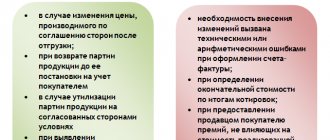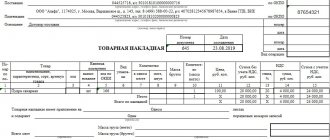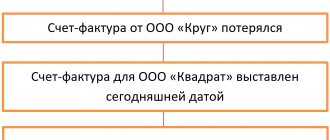Again about the identifier
Most recently, by Decree of the Government of the Russian Federation dated May 26, 2017 No. 625, the line “Identifier of the state contract for the supply of goods (performance of work, provision of services), contract (agreement)” was introduced into the header of the invoice.
But it does not contain the words “if available,” although this is required by paragraphs. 6.2 clause 5 art. 169 Tax Code of the Russian Federation . But the list of mandatory invoice details is contained precisely in the specified article of the Tax Code; the government must only approve and adjust the invoice form taking into account the requirements of the Tax Code of the Russian Federation. But for this line, he was unable to make the correct adjustment the first time, and now this will be corrected.
In addition, indeed, the named identifier is used in a limited number of transactions and only in relation to government contracts. In other cases, it is missing and this line does not require filling.
What numbers need to be entered?
The Tax Code regulates the procedure for filling out accounts (Article 169 “Tax Code of the Russian Federation (Part Two)” dated 08/05/2000 No. 117-FZ (as amended on February 19, 2021). For easier formation and verification of accounts/ f, made a specialized list of digital unified codes.
In the form the s/f are used:
- Product.
- Type of operation performed.
- Unit of measurement (relevant when selling goods and services).
- Manufacturer country.
There was also a place for the product type code
In paragraph 5 of Art. 169 of the Tax Code of the Russian Federation was also introduced by Federal Law No. 150-FZ of May 30, 2016, another detail: a code for the type of product in accordance with the unified Commodity Nomenclature for Foreign Economic Activity of the Eurasian Economic Union. Information provided for in paragraphs. 15 are indicated in relation to goods exported outside the territory of the Russian Federation to the territory of a member state of the Eurasian Economic Union.
The fact is that although according to paragraphs. 1 clause 3 art. 169 of the Tax Code of the Russian Federation, the taxpayer is obliged to draw up invoices, keep books of purchases and sales when performing transactions recognized as subject to VAT; he is exempt from this obligation in relation to transactions that are not subject to taxation in accordance with Art. 149 Tax Code of the Russian Federation .
However, this exemption does not apply to operations for the sale of goods exported outside the territory of the Russian Federation to the territory of a member state of the EurAsEC ( clause 1.1, clause 3, article 169 of the Tax Code of the Russian Federation , also introduced by Federal Law No. 150-FZ ).
When preparing the corresponding invoices, you just need to indicate the named code for the type of product. For this purpose, the column “Product Type Code” with number 1a appeared in the tabular part of the invoice. If there is no data about this code, a dash is placed in the cell.
It turns out that this column should be placed immediately after column 1, which indicates the name of the product (work, service), property rights. Previously, officials left it to the discretion of the taxpayer to decide where to place information about the product code in the invoice (see letters from the Ministry of Finance of Russia dated November 14, 2016 No. 03-07-09/66475 , dated October 14, 2016 No. 03-07-13/1/ 59916 , Federal Tax Service of Russia dated August 17, 2016 No. SD-4-3/ [email protected] ).
Both of these changes, of course, were made to the adjustment invoice form. Only the column for the product type code is numbered 1b.
New rules for storing invoices
From October 1, 2021, the rules for storing invoices will be clearly established. It will be necessary to store them in chronological order as they are exhibited (compiled, corrected) or received. A similar storage approach will apply to electronic document management operator confirmations and notifications to customers of receipt of invoices. All types of invoices (initial adjustment and corrected) will need to be kept for four years. Copies of paper invoices received from intermediaries must be certified by their signatures (principals, principals, developers or forwarders).
How to indicate the number from the customs declaration?
And one more change has been made to the invoice form, but it is no longer caused by amendments to the Tax Code of the Russian Federation. As a result of this change, column 11 will generally differ slightly from what the Tax Code requires.
After all, in paragraphs. 14 clause 5 art. 169 of the Tax Code of the Russian Federation states that the customs declaration number is indicated in the invoice. And column 11 will now be called “Registration number of the customs declaration.”
Previously, the Federal Tax Service, in Letter No. AS-4-3/15798 dated August 30, 2013 , indicated that when filling out this column, two values must be reflected in it, separating them with a fraction sign (/):
- the actual registration number of the customs declaration. It is assigned by an official of the customs authority of the Russian Federation when accepting a customs declaration and is indicated by an official of the customs authority of the Russian Federation in the first line of column “A” of the main and additional sheets of the customs declaration;
- serial number of the goods, it is reflected in column 32 of the main or additional sheet of the customs declaration (if a list of goods was used instead of additional sheets during declaration, then the number in question is in the corresponding list).
Tax officials referred to clause 1 of Order of the State Customs Committee of Russia No. 543, Ministry of Taxation of Russia No. BG-3-11/240 dated June 23, 2000 “On the formation of a cargo customs declaration number after the release of goods.”
True, for example, in the Ruling of the Supreme Arbitration Court of the Russian Federation dated March 22, 2010 No. VAS-3272/10 in case No. A-32-26629/2008-29/465-34/197, the court recognized a different position as correct: the provisions of paragraphs. 14 clause 5 art. 169 of the Tax Code of the Russian Federation do not provide for the mandatory indication of the customs declaration number with the serial number of the goods from column 32 of the main or additional sheet of the customs declaration, indicated by a fraction sign after the cargo customs declaration number. The court came to the conclusion that the absence of the mentioned serial number in the invoice cannot be a basis for refusal to accept the VAT deduction.
Subclause 14, clause 5, art. 169 of the Tax Code of the Russian Federation does not require the indication of a serial number even now. But now the invoice itself stipulates that only the registration number of the customs declaration must be indicated, and the named subparagraph refers specifically to this.
How is the EAEU HS code filled out in ESF in 1C?
In standard solutions, filling out the EAEU HS code when issuing an ESF depends on working with sources of origin and the version of sources of origin used.
In general, filling out the EAEU HS code in BC 3.0 occurs as follows:
- If the accounting system does not keep records by source of origin
, the code from the nomenclature card is indicated in the ESF
(to fill in the code for all operations, you need to configure it )
; - If the accounting system maintains records by source of origin (version 1.0)
- the EAEU Commodity Nomenclature for Foreign Economic Activity is indicated from the source of origin.
If the source does not contain the HS code, the code is taken from the nomenclature card (to fill in the code for all operations, you need to configure)
; - If the scientific system keeps records by sources of origin (version 2.0)
- the EAEU Commodity Nomenclature for Foreign Economic Activity is indicated from the source of origin.
If the source does not contain the HS code, the code is taken from the item card (no additional settings are required).
Since previously the indication of the HS code for foreign trade activities was not mandatory for all categories of goods and transactions with them, taxpayers may encounter situations where the EAEU HS code is not included in the configuration either in the source of origin for such a product or in the item card itself.
Accordingly, the absence of this information makes it impossible to fill out data in the ESF in the accounting system. To prevent incorrect document execution (without the EAEU HS code), it is necessary to conduct an audit and identify items with unfilled or outdated codes.
Important!
How to fill out the TN VED in 1C:
- Filling out the HS code in ESF in 1C: where does the HS code data come from and how to avoid empty lines?;
- What is the CU FEACN code (EAEU TN VED code) and how to determine it yourself?
How to check your nomenclature:
- How to display a list of goods that do not have a Commodity Classification Code indicated in the Nomenclature card?;
- How to identify the remains of goods that do not have a HS code filled in on the item card?
And a few more amendments in the invoice form
The most, obviously, insignificant amendment made by Decree of the Government of the Russian Federation No. 981 to the form of an invoice (including adjustment) concerns the possibility of signing this document instead of an individual entrepreneur by another person authorized by him.
This opportunity is provided to taxpayers in clause 6 of Art. 169 Tax Code of the Russian Federation . But the invoice form did not allow this; it only provides space for the signature of an individual entrepreneur. But now this discrepancy with the Tax Code will be eliminated.
In addition, another clarification has been made to the adjustment invoice form. According to clause 9 of the Rules for filling out an invoice used for VAT calculations (hereinafter referred to as the Rules for filling out an invoice ), the taxpayer has the right to indicate additional information in additional lines and columns of the originally drawn up invoice, including details of the primary document, provided saving the invoice form.
But the Rules for filling out an adjustment invoice used in VAT calculations have not yet allowed for this possibility. That is, formally, it was impossible to indicate in the adjustment invoice additional indicators not provided for by Decree of the Government of the Russian Federation No. 1137 .
However, now clause 8 , according to which additional indicators can be indicated in the adjustment invoice.
Don't make a mistake with the address
For all taxpayers, it is now specified how to fill out lines 2a and 6a of the invoice, which indicate the addresses of the seller and the buyer, respectively ( clauses “d” and “j” of clause 1 of the Rules for filling out an invoice ). Now it is clear that this is not the location of the taxpayer, as it was until now, but namely the address (for legal entities) indicated in the Unified State Register of Legal Entities, within the location of the legal entity, place of residence (for individual entrepreneurs) indicated in the Unified State Register of Legal Entities.
A similar amendment was made for commission agents (agents) purchasing goods (work, services), property rights on their own behalf. They must indicate the address of the seller, reflected in the Unified State Register of Legal Entities, within the location of the legal entity, the place of residence of the individual entrepreneur, indicated in the Unified State Register of Legal Entities (and not their location).
Principals (principals) who draw up invoices and issue them to the commission agent (agent) selling goods (work, services), property rights on their own behalf, must now indicate the address of the buyer, reflected in the Unified State Register of Legal Entities, within the location of the legal entity, place of residence individual entrepreneur specified in the Unified State Register of Entrepreneurs.
It was found that the tax agents listed in paragraphs 2 and 3 of Art. indicate the address in a special way. 161 of the Tax Code of the Russian Federation , - as the location of the seller (according to the agreement with the tax agent), for whom the tax agent fulfills the obligation to pay tax.
But now exactly this procedure has been preserved only for tax agents provided for in paragraph 2 of Art. 161 of the Tax Code of the Russian Federation , that is, when purchasing goods (work, services) on the territory of the Russian Federation from foreign persons who are not registered with the tax authorities as taxpayers.
In paragraph 3 of Art. 161 of the Tax Code of the Russian Federation deals with the rental and purchase of state property. In this case, the tax base is determined by the tax agent separately for each leased property. Tax agents are the tenants of this property. These persons are required to calculate, withhold from income paid to the lessor, and pay the appropriate amount of tax to the budget.
In this case, the tax agent (tenant or buyer of the named property) must indicate the address reflected in the Unified State Register of Legal Entities within the location of the legal entity (according to the agreement with the tax agent) for which the tax agent fulfills the obligation to pay tax.
What it is?
Invoice codes are a set of unified numbers that are given to units of measurement, countries or transactions performed. They are important for simplifying the creation of invoices, sales books and purchase books, as well as their quick verification.
There are separate Regulations regarding each of the categories of codes . There will be no penalty for spelling errors. But it’s better to fill out everything correctly and correct errors correctly. Otherwise, they may issue a demand with an explanation from the tax authorities or claims from clients.
The codes must comply exactly with the standards. It doesn’t matter whether the legal entity is an LLC or an individual entrepreneur, they will be the same. The main essence of codes is their unification.









